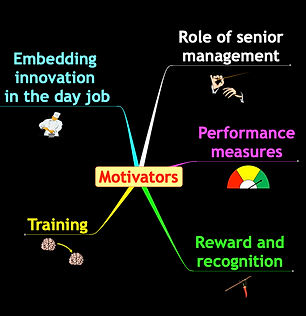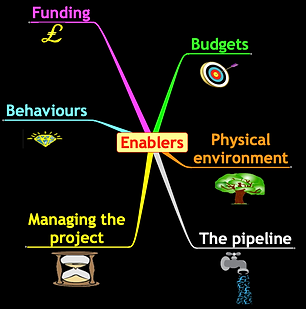Building an innovative culture
"Unlike cutting costs, or making an acquisition, innovation does not happen just because the chief executive wills it.
It is confoundedly difficult to come up with new ideas year in, year out, especially brilliant ones. Underneath the guru's diagrams and charts, most of the available answers seem to focus on two strengths that are difficult to create by diktat: a culture that looks for new ideas, and leaders who know the ones to back."
The Economist, 4th December 1999
Many organisations are very good at generating ideas, but have great difficulty in making something real actually happen, in managing an idea from its genesis right through to full implementation.
If that sounds like your organisation, then read on... for we can help.



Unlike idea generation - which can be done by individuals, but is more powerful and productive when done in small groups - evaluation, and even more so development and implementation, require coordinated and consistent effort across the organisation.
To make innovation happen, you need two 'big things' to be in place, and, in addition, a host of 'little things' too. The two 'big things' are:
■ A fundamental commitment to making innovation a core business process.
■ Appropriate financial 'headroom' to support the investment.
The 'little things' relate to motivators and enablers...
If you look at really innovative organisations and compare them to more ordinary, duller, organisations, you will discover something very important. The uninnovative organisations, for the most part, do the same things as the innovative ones: both types of organisations have budgets, carry out training, run projects, have performance measures.
The difference is that the innovative organisations do all these things in harmony – a harmony which encourages, nurtures, recognises, and rewards, innovation.
A dull company promotes its managers for doing a good job; an innovative one also promotes its managers for doing a good job – but in their case, their definition of ‘good’ includes taking well-managed risks, encouraging ideas in others, and showing an ability to learn from mistakes – a much richer definition of ‘good’ than simply beating this quarter’s profit target.
A dull company has a process for allocating funds to new projects. So too does an innovative company – but in the innovative company, the decision will be made closer to the origin of the idea, as quickly as possible, rather than being relayed from factory to region to division to group, and taking months in the process.
You get the idea: both organisations are doing what might appear on the surface to be the same things – the difference lies more deeply, especially as regards how the organisation motivates and enables everyone to be innovative.
For more information, download our brochure Making Innovation Happen.